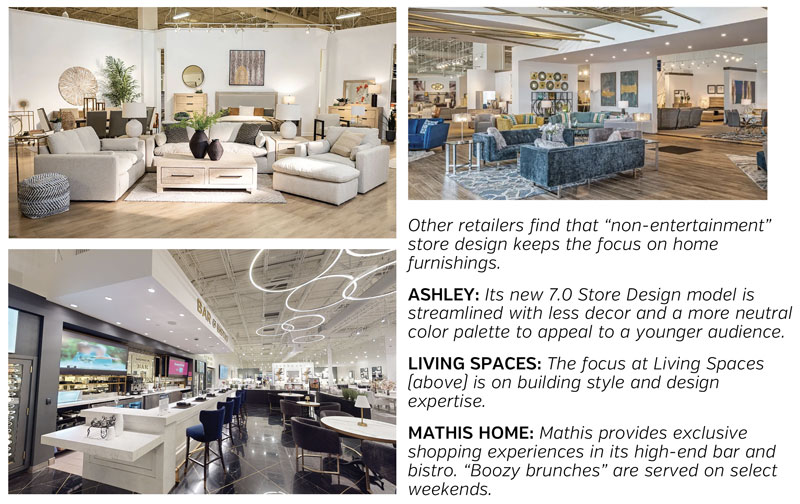Check out both sides of the debate. Does ‘entertainment’ need to be part of a furniture retailer’s store
experience? How
are major retailers dealing with this important question?
There’s a debate in our industry about the need to provide retail “entertainment” to draw customers into stores
and keep
them there. Some retailers have added attractions to give potential customers reasons to visit beyond just
shopping for
home furnishings. The idea is that even if customers don’t think they need a new sofa, dining table or mattress,
retailers benefit from the notoriety and brand exposure. Others have gone down a different path. They’ve doubled
down on
core offerings and focused on their furniture and decor expertise. Both strategies are valid, and we will look
at each
approach’s positives and negatives.
Types of “Entertainment”
Depending on the size of the store and the target audience, various kinds of entertainment have been added to
in-store
experiences. There are many different types of retail entertainment, from simple to extravagant, including:
-
Food and drinks served at in-store cafés.
-
Events such as outdoor BBQ holiday weekend celebrations with food trucks in store parking lots.
-
Events, including musical performances, book signings, wine tastings and sports-watching parties.
-
Exhibits and shows.
- Stage sets and in-store environments that provide “Main Street” or “outdoor” experiences.
- Targeting kids with virtual reality experiences, carousels, movies, miniature golf, ice rinks and more.
- Multi-use complexes.
Whatever a retailer’s approach might be, the goal is to create retail and entertainment destinations that draw
people
in, keep them engaged, and keep them coming back.
Food
Providing food and drink is one of the easiest ways to introduce entertainment into a retail experience.
Furniture Mall
of Missouri introduced its Howdy Café, offering customers its signature custard ice cream and a full menu of
specialty
drinks, cookies and coffee. The Café is a destination for customers to hang out, work and meet friends. It has
outdoor
seating, allowing them to enjoy the weather or take a break from shopping.
Including a café experience increases customers’ store dwell time. Browsing with a refreshing beverage or snack
helps
them feel more comfortable, relaxed and willing to buy. It’s also a space to sit and consider a purchase
decision.
Retailers who haven’t created an in-store café have other food service options. Canadian retailer Tepperman’s,
is
experimenting with having food trucks in their parking lot. Miller Waldrop’s Lubbock, Texas, location has an
outdoor
patio grill area where they host weekend BBQs to build customer relationships.
And, of course, there’s IKEA, one of the first furniture stores that put food at the heart of their store
experience.
IKEA’s budget-friendly Swedish meatballs became a signature dish people trekked to the store to enjoy. The focus
of
their cafeteria on providing hot meals combined with an intricate “maze” of roomset displays keeps customers in
stores
all day, making them true shopping destinations.
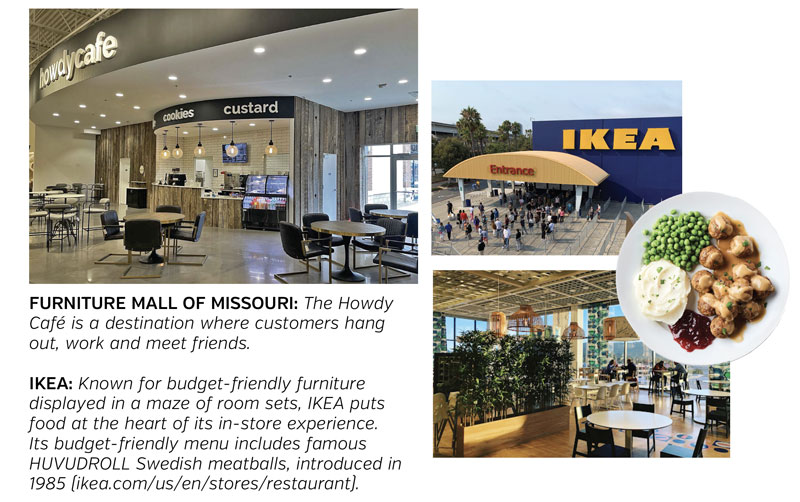
Events & Performances
Nebraska Furniture Mart is known for using events to drive traffic into stores. Its fully programmed event
calendar is
available online, so customers can see upcoming event dates and times (www.nfm.com/events/) These include book readings,
signings, panel discussions, product launches, receptions, and more. NFM also regularly features “Sip & Shop”
wine
tastings, cooking demonstrations and classes.
These events are promoted on NFM’s social media channels and are tagged by customers who attend them. The
Omaha-headquartered retailer also hosts kid-themed events, especially around major holidays, to provide photo
opportunities with the Easter Bunny and Santa Claus.
In addition to offering food and drink at its café, Furniture Mall of Texas went so far as to build a
performance stage
in its recliner department, equipped with a projector screen and sound system. Recliners are displayed in rows
facing
the stage, a focal point of the space. Movies are shown regularly on the big screen, and local musicians are
invited to
perform to build closer community connections. The performance stage is perfect for customers to watch the big
game.
Furniture Mall’s stores are so big that they offer trikes in adult and kid sizes to traverse the store’s wide
aisles and
while shopping. This adds a fun, entertaining aspect to a unique store experience that customers will remember.
Exhibits & Shows
Furniture retailers entertain customers by introducing rotating or permanent displays. For example, Bailey’s
Furniture,
in Anchorage, Alaska, is known for its annual Father’s Day Car Show. Owners of vintage cars are invited to show
off
their models in Bailey’s parking lot. The event features free hot dogs and awards presented to make it a fun
community
event.
“Nebraska Furniture Mart is known for using events to drive traffic into stores. These include book
readings, signings,
panel discussions, product launches, receptions, and more.”
However, Bailey’s does not stop there. Its main store displays a permanent collection of over 650 cookie jars.
Also
featured is a “Bush Pilots of Alaska” exhibit that celebrates aviation and honors pilots who significantly
contributed
to Alaska’s history. Bailey’s Furniture describes its store experience as “so interesting that Alaskans can’t
help but
want to see it.”
Hefner Furniture in Poplar Bluff, Missouri, makes a similar claim: “We are not just a store; we are a
destination
experience.” Hefner’s includes a compelling exhibit of antique cars, boats, planes, and auto memorabilia that
they say
keeps the whole family engaged. Of course, the free popcorn and soda drinks in their ‘50s-style café help.
Hefner continues to add unique pieces to their collection and features some of the exhibits outside. For example,
there
is a two-seater training jet that, when installed, drew a crowd of curious customers. Many of them entered the
store to
shop. For Hefner, these exhibits and artifacts create interest and generate free advertising. Google has listed
the
store as a “tourist attraction.”
Stage Sets, Waterfalls & Other Unique Experiences
Furniture retailers create unique, customized environments that engage customers. For example, Hefner Furniture
built a
dramatic 35-foot-tall mountain waterfall in its main store, featuring native wildlife and flora representations.
Bailey’s Furniture also built a large waterfall feature in their main store with animal-mounted displays. These
customized environments proudly tell stories of how stores are interconnected with their communities.
Boulevard Home in St. George, Utah, has long been known for its impactful “boulevard” in-store concept, complete
with
faux storefronts, a fountain, a gazebo, and a full-service café. This boulevard establishes a sense of wonder
within the
larger store environment and allows customers to relax during their shopping experience.
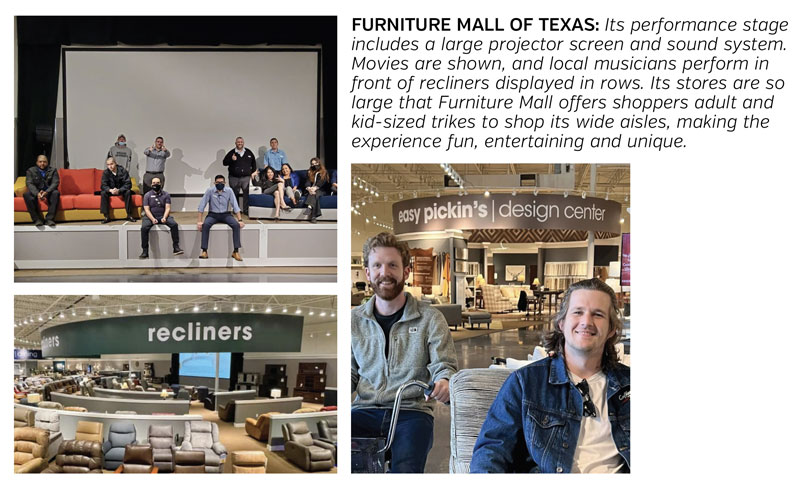
Last year, Boulevard Home opened a new 100,000-square foot store in Las Vegas, reinventing and modernizing this
concept.
The store features a large cascading waterfall with built-in seating and plantings, a 20-foot-tall stone boulder
with a
rock garden, an open gazebo, a café for refreshments, and an active kids’ area.
Creating a designated kids’ area is important for many furniture retailers. Kids’ areas provide places where
parents can
leave their children, knowing they will be safe and entertained while parents make important furniture purchase
decisions. These environments are becoming more creative. Tepperman’s new St. Catharines store outside of
Toronto,
engaged a kids’ play designer from the Netherlands to recreate the history of Tepperman’s in a play environment.
The
area features interactive games and digital devices in a home-like setting. Included is a model of Tepperman’s
original
delivery truck from the 1930s.
“Bailey’s does not stop there. Its main store displays a permanent collection of over 650 cookie jars.
Also
featured is
a ‘Bush Pilots of Alaska’ exhibit.”
Furniture Mall of Missouri also brought its history to life in its new Lee’s Summit store. Recreated was a scene
from
the 1930s community where, according to the history page at www.thefurnituremall.com, “Ben and Eva Winter took a
risk
and invested in a Derby Gas Station, along with a soda fountain, which they named ‘The Howdy Come In’ on Highway
50,
west of Emporia, Kansas.” A silo tower, based on the original store design, was built, and a classic Studebaker
and gas
pumps were sourced to emotionally connect customers to Furniture Mall’s history.
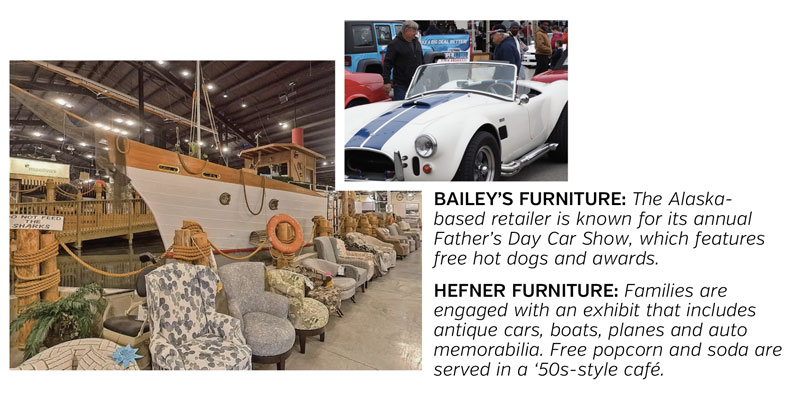
All-Out Entertainment
No article on this topic would be complete without mentioning the most well-known entertainment-focused
retailer,
Jordan’s Furniture. Jordan’s has built its reputation on entertainment and providing a destination shopping
experience
for families and kids. Its tagline is “not just a store, an experience.” Stores in Reading and Natick,
Massachusetts,
feature an IMAX theater sponsored by Sunbrella. Jordon’s bought what was left of an “Enchanted Village” display
from the
1960s, updated it and opens it up yearly to the public during the Christmas season.
“Boulevard Home has long been known for its impactful ‘boulevard’ in-store concept, complete with faux
storefronts, a
fountain, a gazebo, and a full-service café.”
Some of its stores include adventure rope courses, a trapeze school, a “Liquid Fireworks” light and sound show,
and
more. There’s a theme-park feel. On certain nights, the place is packed with people lining up for ice cream or
to try
out a course. The entertainment aspect attracts people looking for an experience on a weekend or a Friday night.
Jordan’s Furniture also ensures that its furniture displays are engaging and entertaining. Its leather
department mimics
the look of an old library, complete with wood paneling, high ceilings and a wrap-around mezzanine, adding
another level
to the “theater” of their shopping/entertainment experience.
Mixed-Use Development
Nebraska Furniture Mart (NFM) is synonymous with entertainment as it continues to develop ambitious projects.
After
1975, when its Omaha, Nebraska, store was rebuilt following major tornado damage, the store campus continued to
grow,
becoming the world’s largest furniture store. Years later, NFM is still expanding, taking on a real estate
developer
role with its expansion projects.
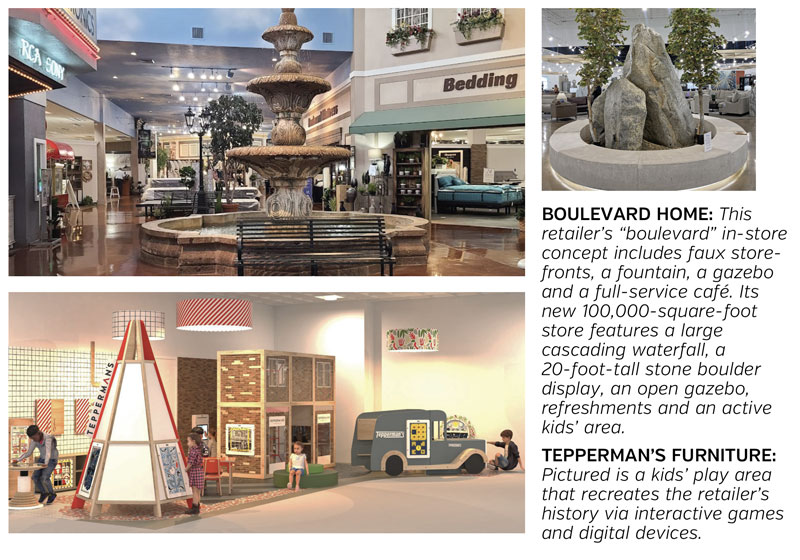
In Dallas, NFM developed its “Grandscape” complex, equipped with a Ferris wheel and musical gondolas extending
across
400 acres, including over 3.9 million square feet. This makes it one of the country’s largest mixed-use real
estate
developments, with a furniture store as the anchor. It will eventually include everything from hotels to other
retail
stores, restaurants, and residential living spaces.
Scheels, which claims to be the largest sporting goods store in the world, complements NFM’s destination-driven
shopping
experience. Scheels is working on a 240,000-square foot “retail and entertainment” destination in Cedar Park,
Texas, as
part of NFM’s new development in Austin. The store will include a Ferris wheel, an aquarium, rollerball, a
synthetic ice
rink, a candy factory, a café, a shooting gallery, an arcade, and an archery center. NFM is developing the
Austin
complex with its 500,000-square-foot store at the heart of the development. Also included will be a hotel, a
convention
center and additional retail.
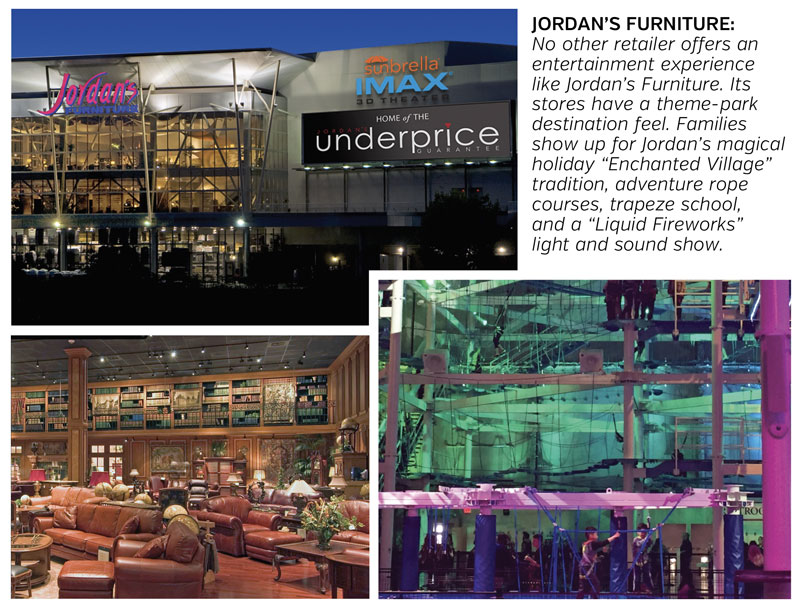
Positives & Negatives
Brick-and-mortar retailers must get more creative to bring shoppers back into physical store environments. With
e-commerce and online shopping accounting for an ever-increasing percentage of sales, entertainment-based
attractions do
an excellent job of attracting families looking for kids’ entertainment, especially on the weekends. If that
entertainment is free, it provides another motivation for families to visit stores, stay longer and eventually
make
purchases.
“Hefner Furniture built a dramatic 35-foot tall mountain waterfall in its main store, featuring
native wildlife and flora representations.”
Other significant benefits of adding entertainment to a store experience are added renown and exposure. Stores
get
word-of-mouth recommendations and social media buzz, becoming publicity machines, especially if they work to get
regular
press coverage for events and activities. This, in turn, creates brand interest and curiosity, driving
additional store
traffic.
However, before signing off on in-store entertainment, retailers must consider the quality of the entertainment
they
plan to offer and its relevance to their customers. In other words, it needs to create value for retailers by
helping to
build community and a loyal customer base. Retailers should avoid creating any form of entertainment that won’t
effectively encourage repeat customers. Otherwise, it risks being seen as gimmicky and inauthentic, distracting
from a
retailer’s core business.
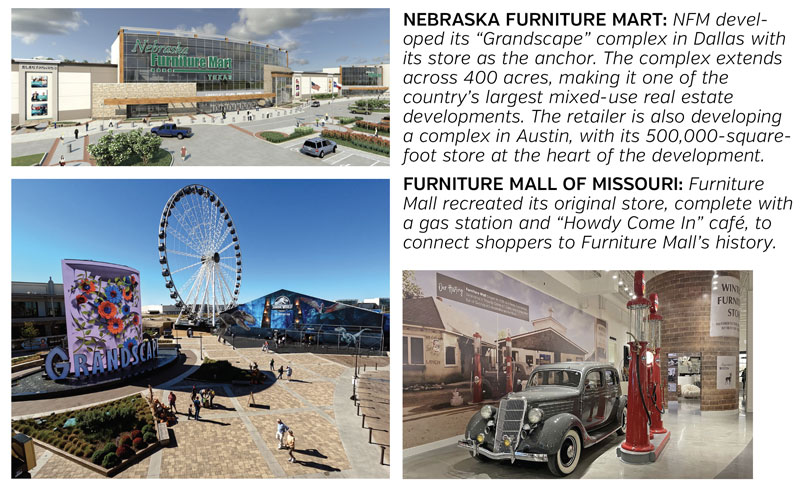
Non-Entertainment Approach
Keep in mind that entertainment features are not the only way to create incremental traffic and brand interest.
Many
retailers, including those listed below, have found just as much success by keeping their focus on furniture.
Ashley, for example, offers a trend-oriented, promotional in-store experience. Its new 7.0 Store Design model is
streamlined, with less decor and a more neutral color palette. Some have called their new simplified design too
sterile
or bland, but their goal is to appeal to a younger audience, which they have found “dislike noisy, cluttered and
disorganized stores.”
Rooms To Go’s primary focus is to inspire customers with beautiful room presentations and a strong accessories
story.
Living Spaces is another retailer that has not incorporated entertainment features into its stores. Instead, it
concentrates on building style and design expertise to make offerings more personal and appealing. The retailer
offers
free design services, which is why many customers come into the store.
“Living Spaces is another retailer that has not incorporated entertainment features. Instead, it
concentrates on
building style and design expertise to make offerings more personal and appealing.”
Mathis Home goes further, offering design services in an independent shopping environment, separate from their
main
store. Branded as Mathis Design Studio, shoppers can make personal appointments with in-house designers,
providing
exclusive shopping experiences. In the Design Studio, a high-end bar and bistro keep customers in the store.
Boozy
brunches bring them in on select weekends.
These “non-entertainment” techniques keep the focus on home furnishings and design, reinforce retailers’ core
offerings,
position stores as experts and provide places for customers to shop, relax, and be inspired.
Conclusion
Regardless of your approach to entertainment, the path to success is to find the right strategy that fits your
store’s
environment, attracts the customers you want, and keeps shoppers coming back.
